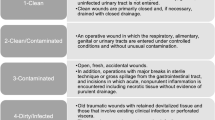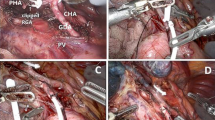Abstract
Background
The clinical course of hepatectomy in patients with preexisting bilioenteric anastomosis (BEA) is poorly understood. The aim of this study was to evaluate the potential influence of preexisting BEA on organ/space surgical site infection (SSI) after hepatectomy.
Methods
We analyzed consecutive hepatectomies performed between March 2005 and January 2015. Patients’ background, operative results, and complications were compared between hepatectomies with and without preexisting BEA.
Results
Twenty-two hepatectomies with preexisting BEA were identified among 1745 hepatectomies. The rate of organ/space SSI was much higher in hepatectomies with preexisting BEA than in those without preexisting BEA (40.9 vs. 6.4 %, P < 0.001). Multivariate analyses identified four variables as independent factors associated with organ/space SSI: liver-directed chemotherapy [odds ratio 5.06 (95 % confidence interval 2.29–10.54), P < 0.001], operative time ≥ 300 min [2.40 (1.30–4.54), P = 0.006], estimated blood loss ≥ 500 ml [2.34 (1.26–4.31), P < 0.001], and preexisting BEA [12.08 (4.54–31.32), P < 0.001]. A higher rate of organisms from intestinal flora was detected in organ/space SSI after hepatectomies with preexisting BEA (77.8 vs. 21.3 % without BEA, P = 0.002). Analysis of hepatectomies with preexisting BEA identified selection of antibiotics for prophylaxis as the sole risk factor for organ/space SSI (P = 0.049 for cefazolin versus other antibiotics targeting intestinal flora).
Conclusions
Preexisting BEA is an independent risk factor for the development of organ/space SSI after hepatectomy. Antibiotics targeting intestinal flora are strongly recommended for prophylaxis of infectious complications.



Similar content being viewed by others
References
Yanaga K, Kanematsu T, Takenaka K et al (1986) Intraperitoneal septic complications after hepatectomy. Ann Surg 203:148–152
Andersson R, Saarela A, Tranberg KG et al (1990) Intraabdominal abscess formation after major liver resection. Acta Chir Scand 156:707–710
Minagawa M, Makuuchi M, Torzilli G et al (2000) Extension of the frontiers of surgical indications in the treatment of liver metastases from colorectal cancer: long-term results. Ann Surg 231:487–499
Belghiti J, Hiramatsu K, Benoist S et al (2000) Seven hundred forty-seven hepatectomies in the 1990s: an update to evaluate the actual risk of liver resection. J Am Coll Surg 191:38–46
Yamashita Y, Hamatsu T, Rikimaru T et al (2001) Bile leakage after hepatic resection. Ann Surg 233:45–50
Taketomi A, Kitagawa D, Itoh S et al (2007) Trends in morbidity and mortality after hepatic resection for hepatocellular carcinoma: an institute’s experience with 625 patients. J Am Coll Surg 204:580–587
Chok KS, Ng KK, Poon RT et al (2009) Impact of postoperative complications on long-term outcome of curative resection for hepatocellular carcinoma. Br J Surg 96:81–87
Farid SG, Aldouri A, Morris-Stiff G et al (2010) Correlation between postoperative infective complications and long-term outcomes after hepatic resection for colorectal liver metastasis. Ann Surg 251:91–100
Mavros MN, de Jong M, Dogeas E et al (2013) Impact of complications on long-term survival after resection of colorectal liver metastases. Br J Surg 100:711–718
de Baere T, Risse O, Kuoch V et al (2003) Adverse events during radiofrequency treatment of 582 hepatic tumors. Am J Roentgenol 181:695–700
Shibata T, Yamamoto Y, Yamamoto N et al (2003) Cholangitis and liver abscess after percutaneous ablation therapy for liver tumors: incidence and risk factors. J Vasc Interv Radiol 14:1535–1542
Woo S, Chung JW, Hur S et al (2013) Liver abscess after transarterial chemoembolization in patients with bilioenteric anastomosis: frequency and risk factors. Am J Roentgenol 200:1370–1377
Mezhir JJ, Fong Y, Fleischer D et al (2011) Pyogenic abscess after hepatic artery embolization: a rare but potentially lethal complication. J Vasc Interv Radiol 22:177–182
Fujii K, Yamamoto J, Shimada K et al (1999) Resection of liver metastases after pancreatoduodenectomy: report of seven cases. Hepatogastroenterology 46:2429–2433
De Jong MC, Farnell MB, Sclabas G et al (2010) Liver-directed therapy for hepatic metastases in patients undergoing pancreaticoduodenectomy: a dual-center analysis. Ann Surg 252:142–148
Mangram AJ, Horan TC, Pearson ML et al (1999) Guideline for prevention of surgical site infection, 1999. Centers for Disease Control and Prevention (CDC) hospital infection control practices advisory committee. Am J Infect Control 27:97–132
Sourrouille I, Gaujoux S, Lacave G et al (2013) Five days of postoperative antimicrobial therapy decreases infectious complications following pancreaticoduodenectomy in patients at risk for bile contamination. HPB 15:473–480
Saiura A, Yamamoto J, Koga R et al (2006) Usefulness of LigaSure for liver resection: analysis by randomized clinical trial. Am J Surg 192:41–45
Zimmitti G, Vauthey JN, Shindoh J et al (2013) Systematic use of an intraoperative air leak test at the time of major liver resection reduces the rate of postoperative biliary complications. J Am Coll Surg 217:1028–1037
Mise Y, Vauthey JN, Zimmitti G, et al (2015) Ninety-day postoperative mortality is a legitimate measure of hepatopancreatobiliary surgical quality. Ann Surg
Dindo D, Demartines N, Clavien PA (2004) Classification of surgical complications: a new proposal with evaluation in a cohort of 6336 patients and results of a survey. Ann Surg 240:205–213
Clavien PA, Barkun J, de Oliveira ML et al (2009) The Clavien-Dindo classification of surgical complications: five-year experience. Ann Surg 250:187–196
Koch M, Garden OJ, Padbury R et al (2011) Bile leakage after hepatobiliary and pancreatic surgery: a definition and grading of severity by the International Study Group of Liver Surgery. Surgery 149:680–688
Bratzler DW, Dellinger EP, Olsen KM et al (2013) Clinical practice guidelines for antimicrobial prophylaxis in surgery. Surg Infect (Larchmt) 14:73–156
Hochwald SN, Burke EC, Jarnagin WR et al (1999) Association of preoperative biliary stenting with increased postoperative infectious complications in proximal cholangiocarcinoma. Arch Surg 134:261–266
Povoski SP, Karpeh MS, Conlon KC Jr et al (1999) Preoperative biliary drainage: impact on intraoperative bile cultures and infectious morbidity and mortality after pancreaticoduodenectomy. J Gastrointest Surg 3:496–505
Jagannath P, Dhir V, Shrikhande S et al (2005) Effect of preoperative biliary stenting on immediate outcome after pancreaticoduodenectomy. Br J Surg 92:356–361
Sugawara G, Ebata T, Yokoyama Y et al (2013) The effect of preoperative biliary drainage on infectious complications after hepatobiliary resection with cholangiojejunostomy. Surgery 153:200–210
Yoshioka R, Saiura A, Koga R et al (2011) Predictive factors for bile leakage after hepatectomy: analysis of 505 consecutive patients. World J Surg 35:1898–1903
Sadamori H, Yagi T, Shinoura S et al (2013) Risk factors for major morbidity after liver resection for hepatocellular carcinoma. Br J Surg 100:122–129
Mise Y, Hasegawa K, Shindoh J et al (2014) The feasibility of third or more repeat hepatectomy for recurrent hepatocellular carcinoma. Ann Surg 262:347–357
Hoffmann R, Rempp H, Schmidt D et al (2012) Prolonged antibiotic prophylaxis in patients with bilioenteric anastomosis undergoing percutaneous radiofrequency ablation. J Vasc Interv Radiol 23:545–551
Nelson RL, Gladman E, Barbateskovic M (2014) Antimicrobial prophylaxis for colorectal surgery. Cochrane Database Syst Rev 5:CD001181
Lewis RT, Allan CM, Goodall RG et al (1983) Are first-generation cephalosporins effective for antibiotic prophylaxis in elective surgery of the colon? Can J Surg 26:504–507
Hoffmann CE, McDonald PJ, Watts JM (1981) Use of peroperative cefoxitin to prevent infection after colonic and rectal surgery. Ann Surg 193:353–356
Kaiser AB, Herrington JL, Jacobs JK Jr (1983) Cefoxitin versus erythromycin, neomycin, and cefazolin in colorectal operations. Importance of the duration of the surgical procedure. Ann Surg 198:525–530
Shatney CH (1984) Antibiotic prophylaxis in elective gastro-intestinal tract surgery: a comparison of single-dose pre-operative cefotaxime and multiple-dose cefoxitin. J Antimicrob Chemother 14(Suppl B):241–245
Acknowledgments
We thank Jun Takano, Department of photo center, Cancer Institute Hospital, Japanese Foundation for Cancer Research, Tokyo, for the valuable edition of digital illustration as schemata.
Author information
Authors and Affiliations
Corresponding author
Ethics declarations
Conflict of interest
None of the authors have any actual or potential conflict of interest in relation to the submission of this article.
Rights and permissions
About this article
Cite this article
Matsumura, M., Saiura, A., Inoue, Y. et al. High Rate of Organ/Space Surgical Site Infection After Hepatectomy with Preexisting Bilioenteric Anastomosis. World J Surg 40, 937–945 (2016). https://doi.org/10.1007/s00268-015-3340-x
Published:
Issue Date:
DOI: https://doi.org/10.1007/s00268-015-3340-x




